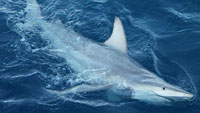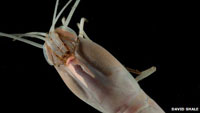 Given that we live on an ocean planet, it is remarkable how little know of the creatures of the sea. Recently, for example, scientists discovered the first hybrid sharks to be found in Australian waters. Also, teams of American and British researchers have just discovered new species of life in deep sea hydrothermal vents.
Given that we live on an ocean planet, it is remarkable how little know of the creatures of the sea. Recently, for example, scientists discovered the first hybrid sharks to be found in Australian waters. Also, teams of American and British researchers have just discovered new species of life in deep sea hydrothermal vents.
The Australian sharks are believed to be the result of in-breeding between genetically distinct Australian blacktip, whose range extends north from Brisbane, and the larger common blacktip found in southeastern coastal waters.
Hybrid Sharks Found in Australian Waters
The scientists say interbreeding between the two shark species is a sign the animals are adapting to climate change and they also warn that hybridization could make the sharks stronger.
“Hybridization could enable the sharks to adapt to environmental change as the smaller Australian blacktip currently favors tropical waters in the north while the larger common blacktip is more abundant in sub-tropical and temperate waters along the south-eastern Australian coastline,” Ovenden said.
 British and American researchers have discovered species unknown to science in the deep sea hydrothermal vents in the South West Indian Ridge in the Indian Ocean. These deep sea vents were unknown until 1977 when scientists were surprised to find them teaming with life in water at temperatures of more than 800 degrees.
British and American researchers have discovered species unknown to science in the deep sea hydrothermal vents in the South West Indian Ridge in the Indian Ocean. These deep sea vents were unknown until 1977 when scientists were surprised to find them teaming with life in water at temperatures of more than 800 degrees.
Deep-sea vents, just north of Antarctica, flourish with species never seen before
Oceanographers exploring some of the most remote deep-sea hot springs ever found have discovered what they say is a “riot of life” in a distinct biological zone that no one knew existed. They said the exploration, which occurred more than a mile down in the ocean just north of Antarctica, uncovered the most strikingly unique assemblage of life-forms found in decades, including thousands upon thousands of a species of crab never seen before, as well as new barnacle, anemone, snail and starfish species.
“It’s remarkable that we can be in the 21st century and still not know fundamental things about what lives on our planet,” said Cindy Van Dover, director of Duke University’s marine laboratory, who has been studying life at deep sea vents for 30 years but was not involved in the new discoveries. “This is really exciting because it keeps open the door for even more discovery down the road.”
Deep-sea creatures at volcanic vent
The team, from the University of Southampton, was particularly interested in the vents on the South West Indian Ridge because this range is linked to the Mid Atlantic Ridge and the Central Indian Ridge, where vent life has been well documented.
This area is also unusual because it is an “ultra-slow spreading” ridge, which means it is less volcanically active than other ridges, with fewer vents that are further apart.
Dr Jon Copley, chief scientist of the Indian Ocean vents project, said: “This place is a real crossroads in terms of the vent species around the world.”
Thanks to Alaric Bond and Irwin Bryan for passing the articles along.
